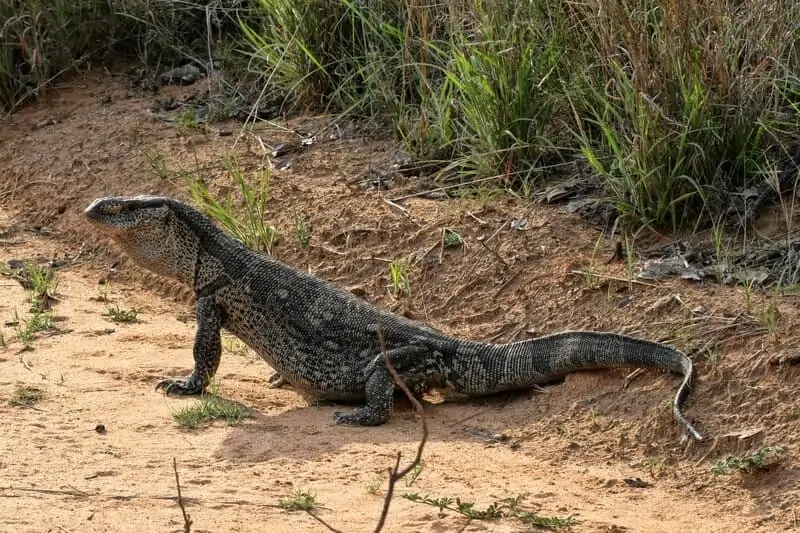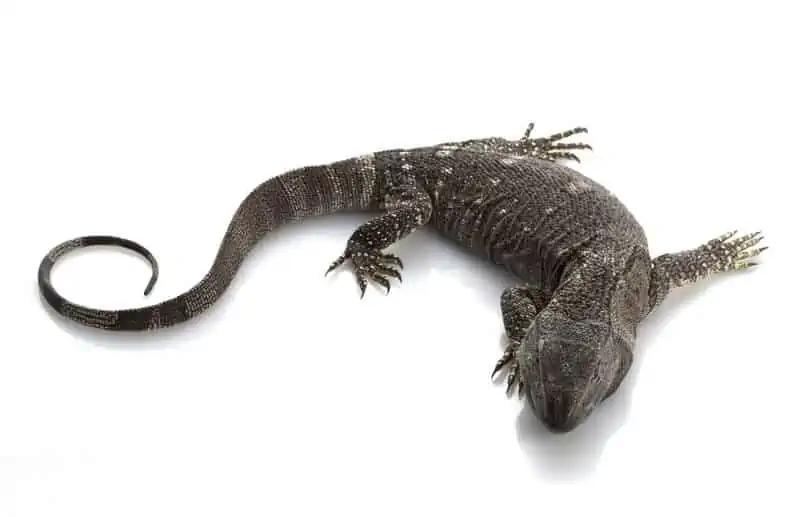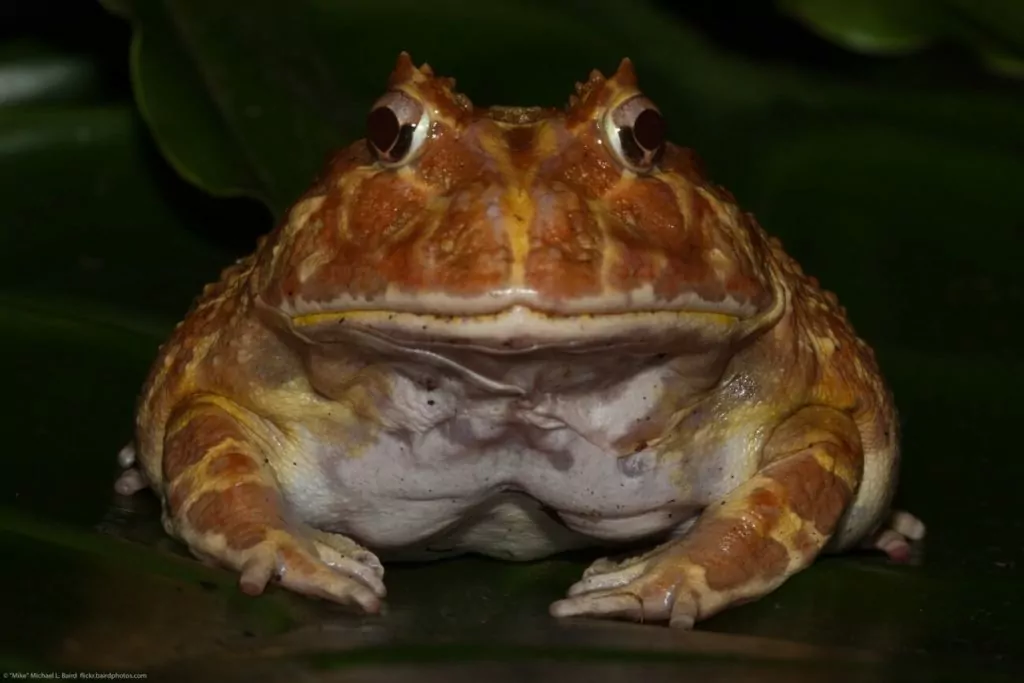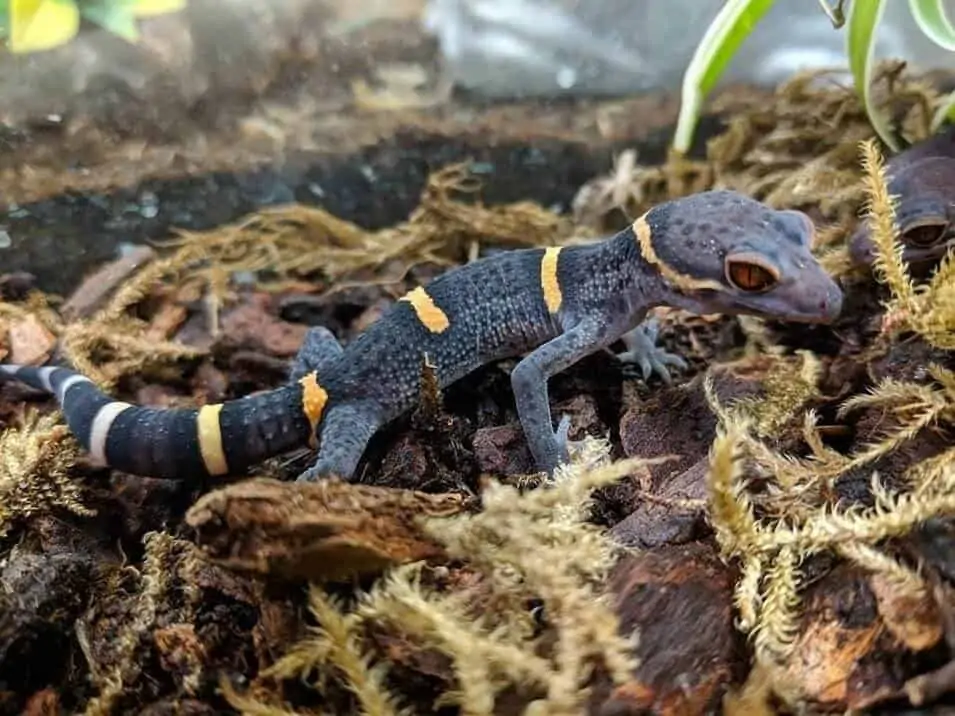Black-throated monitors are fascinating and impressive animals that many reptile-lovers dream of owning at some point. However, doing so requires knowledge and access to ample space!
This guide will cover everything you need to know about black-throated monitor care, so you can understand what needs to be done if you want to own these reptiles.
Table of Contents
Species Summary
The black-throated monitor (Varanus albigularis microstictus) is a deceivingly menacing-looking reptile. These creatures are giant monitor lizards that can grow longer than most humans are tall. However, they’re relatively docile and can actually make fantastic pets.
The monitor is one of three subspecies of the rock monitor. It joins the white-throated iguana and Angolan white-throated monitor subspecies. But of course, this animal is unique in its own right.
It hails from the savannahs of Tanzania in East Africa. It prefers arid locations, thriving in dry savannahs or forested areas.
The black-throated monitor is an interesting animal to keep. It’s pretty rare in the pet community. Herpetologists often praise its even temperament, but the sheer size of the animal makes it a serious commitment for even skilled reptile keepers.
Appearance & Colors
These lizards are quite beautiful. Seeing one in person is a real treat, and owners are usually never shy to show them off! It’s not hard to see why.
As you can guess from the name, these lizards have a black-colored throat. It offers a nice contrast to their forked tongues, which are usually pink or blue.

The body of the monitor is usually brown or gray. Most have a mottled appearance. White or yellow markings typically line the body, too.
The lizard’s scales are large and distinct. Like most reptiles from the region, black-throated monitors have rough skin that’s perfect for blending in with dry bush.
The head isn’t super defined. It’s round and blunt. Sagging skin on the neck further cements that round, oblong-shaped head.
The body is pretty bulky. But make no mistake: The lizard is anything but weak. They have strong leg muscles to move their massive bodies, and the lizard can move quickly if needed.
Expert Tip: Sexual dimorphism is subtle. In most cases, males are slightly bigger than females. But the best way to sex these animals is through probing and x-rays.
Lifespan
The black-throated monitor is not an animal you want to pick up on a whim. These creatures require decades of commitment. In captivity, the typical black-throated monitor lifespan is between 20 and 25 years! They may live even longer in the wild.
Of course, there are no guarantees either way. These lizards are living creatures susceptible to illness just like you.
That said, the best way to prolong the life of your lizard as much as possible is to provide top-notch care. High-quality husbandry and good living conditions can make all the difference, helping you keep your monitor healthy and avoid unnecessary early death.
Average Size
Here’s where the black-throated monitor is impressive! It’s a beast of a lizard! The size of a full-growth black-throated monitor can reach up to seven feet in length.
Most of that length comes from the tail, but it’s a jaw-dropping size nonetheless. Not only is the tail long and powerful enough to whip back and forth, but the lizard’s strong leg muscles help it move around its significant body mass.
Expert Tip: Adults can tip the scales at 60 pounds. This particular lizard is the largest of the rock monitor subspecies.
Black-Throated Monitor Care
Thanks to the reptile’s size, taking good care of a black-throated monitor is no easy task. While relatively docile, they have distinct needs that can be challenging for most reptile lovers to manage.
If you feel you’re up for the task, here are some guidelines to remember when it comes to black-throated monitor care.
Enclosure Size
Let’s talk about the most challenging part of owning a black-throated monitor: Finding a suitable living space!
These lizards can reach lengths of 7 feet! That’s bigger than most grown adults. As you can imagine, finding an enclosure that’s big enough is a massive undertaking.
You have a few different routes to go here.
The most convenient choice is to use a medium or large-sized bedroom. Many dedicated reptile enthusiasts transform entire rooms in their homes for these massive monitors. Around 100 square feet is ideal when it comes to enclosure size for a black-throated monitor. That’s enough room for these creatures to roam.
Black-throated monitors like to explore their surroundings a bit, so it pays to have a large room that they can explore unencumbered. You may even get comfortable letting your monitor roam the house at some point!
You can use a standalone enclosure if you don’t have a separate room. However, there’s a good chance you’ll have to build it from scratch.
Most owners will use plexiglass to build a large enclosure that can handle the environmental needs of the monitor. You might be able to get away with creating an outdoor enclosure for your monitor if you live in a super arid environment.
But for most people, enclosed living spaces are necessary to keep these lizards in the right conditions.
As for dimensions, the bare minimum is seven or eight feet in all directions. The monitor should have enough room to turn, stretch, and get comfortable. But as we mentioned earlier, these lizards like to explore, so bigger is always better.
What To Put In Their Habitat
Once you have your enclosure figured out, it’s time to start building a cozy environment!
That all starts with a layer of substrate material. Black-throated monitors are diggers. They love to dig in the substrate and sometimes burrow a little. You don’t have to provide a super thick layer of substrate, but it needs to be safe enough for their claws to work through.
Loose substrates like coconut coir and reptile-friendly soil mixes are your best bed. Whatever you choose, you’ll need a lot of it. A decent, foot-deep layer is ideal.
Below that, you can use vinyl flooring. It’ll make cleanups a breeze.
For decor, try natural items that replicate their natural habitat. You can use faux plants, bushes, and even some taller trees. These lizards are semi-arboreal, so providing a few climbing surfaces is always a good idea.
The black-throated monitor needs plenty of stimulation throughout the day. Don’t skimp on the decor. Give your lizard several items to explore and interact with daily.
Avoid overcrowding and be mindful of how your lizard navigates the space. But do your best to create an enriching environment full of fun for these massive lizards.
Expert Tip: You can add a large hide box or shade source for good measure. Even these large beasts need a place to feel safe and secure. An overturned wooden box will do the trick.
Temperature & Lighting
Another challenge with black-throated monitor care is managing the temperature and lights. These lizards will undoubtedly add to your light bill, but the lighting requirements are necessary for the reptile’s health. More on that later.
The natural habitat of this monitor is tropical. Tanzania rarely falls below 68 degrees Fahrenheit year-round.

Using lights, create daytime ambient temperatures of 85 to 90 degrees Fahrenheit. At night, temperatures can fall to 78 degrees. But if your area gets any lower than that, use heat transmitters throughout the enclosure.
You want to stick to a typical day and night schedule. These lizards are diurnal. That means that they sleep throughout the night and are most active during the day. Without a regular light cycle, you could throw off their circadian rhythm and cause health problems.
In addition to the ambient heat, you’ll need a basking spot. Like other reptiles, black-throated monitors self-regulate their body temperature by moving throughout their environment. They’ll move under plants to get shade when they need to cool down. But they’ll turn to the basking spot when they need to heat up.
Using a basking lamp, focus the light on one area to raise temperatures to around 100 and 110 degrees Fahrenheit. Dedicating one corner of the enclosure to the heated basking spot is a common method for assisting with thermoregulation.
Another consideration is UV lighting.
This is a detail you’ll have to cover if your black-throated monitor is living indoors. That’s the case for most owners, so it’s a necessary addition.
UV lights help reptiles process calcium. These lamps simulate the effects of sunlight and vitamin D. Without it, the lizard can suffer various health issues.
Install full-spectrum UV lamps in your enclosure and position them to shine throughout the entire space. They should be on a timer to simulate your area’s natural day and night cycle.
Expert Tip: Make sure to replace bulbs every six months. You often can’t see the UV lights working, so they can quickly go bad without you realizing it. Sticking to a standard replacement cycle ensures that your monitor stays healthy.
Humidity
Usually, humidity is a big deal for reptiles. It’s still important for the black-throated monitor, but it’s not as critical to their overall health. You don’t have to worry about maintaining a high level of humidity around the clock.
For this lizard, 20 to 50 percent humidity is the ideal range.
It’s wise to invest in a hygrometer. While you have a broader range to work with, you want to ensure that things don’t fall below or rise over the maximum. Too much in either direction could be problematic.
To increase humidity levels, all you have to do is mist the environment. A few spritzes of fresh water will do the trick.
To lower it, you’ll need to increase air circulation to speed up moisture evaporation.
Water
Of course, water is a must when keeping any pet. But the black-throated monitor will use the water differently than you would expect. They may lap it up and drink it, but they primarily use the water you provide for soaking.
Soaking helps them stay hydrated and helps during times of shedding.
As you can imagine, you’ll need a pretty big water dish for these monitors!
The go-to for most herpetology enthusiasts is to use a large, plastic kiddie pool. These pools are readily available, relatively cheap, and sturdy enough to withstand regular use.
It doesn’t have to be massive. Black-throated monitors will not swim around, but it should be big enough for the lizard to soak their entire bodies.
For easy access, provide a ramp or two. If you live in a colder climate, you may also need to install a tamper-proof heater to keep water temperatures around 80 degrees Fahrenheit.
Keep an eye on the water and be proactive about keeping it clean. Replace the water frequently and address messes as they occur. Many monitors use their water receptacles as toilets, so they can get messy quickly.
Cleaning the pool regularly will limit the possibility of health issues arising.
Black-Throated Monitor Food & Diet
Black-throated monitors are obligate carnivores. They cannot digest plant matter and rely on an exclusive meat diet. In the wild, they’re natural-born hunters and will cover up to seven miles of ground to catch their prey.
A varied diet is the best approach to keeping these lizards healthy. Sticking to one source of protein could make their meals stale. Plus, it would deprive them of all the nutrients they need to survive.
Good foods to include in meals include:
- Rodents
- Fish
- Eggs
- Crickets
- Roaches
- Mealworms
- Crustaceans
- Chicken
Those are just a few food items worth considering. Black-throated monitors are highly opportunistic in the wild and will eat what they can get. So, you can feel free to experiment if you stay within the realm of what they would typically consume in the wild.
Make sure to source the foods from a reliable pet store or supply company, whatever you choose for meals. It’s not a good idea to hunt for food on your own or even buy leftovers from a slaughterhouse. There’s always a risk of bacteria and disease.
Food items from pet stores are usually clean and safe. Insects should be gut-loaded, too.
Speaking of insects, most experts recommend using the bugs to provide supplements. Dust every bug with multivitamin supplements and calcium powder. They will help avoid potential health issues and fill any gaps in the diet.
So, how much should you feed a black-throated monitor? You can choose to provide these lizards daily or every other day. Younger monitors usually fare better with daily meals, and many owners continue that schedule throughout the animal’s life.
Expert Tip: There’s no exact serving size. What works for each lizard depends on what you feed them and their overall size. Feed until your black-throated monitor isn’t interested in eating anymore.
Keep an eye on their body condition and adjust accordingly.
Potential Health Issues
For the most part, black-throated monitors are healthy animals. They’re not as susceptible to parasitic infections as smaller lizards. They can still happen, but those issues are few and far between.
The most common ailments you must watch out for include impaction and metabolic bone disease.
Impaction occurs when the lizard eats something non-digestible. It gets stuck in their system and can cause potentially dangerous blockages. If you suspect their gut is impacted, bring them to an exotic animal vet as soon as possible.
The same goes for symptoms of metabolic bone disease. This condition results from poor calcium levels and a lack of UV lighting. It causes the bones to become brittle, eventually breaking and causing other injuries.
Always make sure your UV lamps are working. Also, make sure to dust gut-loaded insects with supplements regularly. Those two steps can do a lot to avoid health problems.
Behavior & Temperament
Black-throated monitors are more easy-going than their appearance would leave you to believe. With proper training and socialization, they can be relatively docile. They don’t cause much trouble, and most will spend their days burrowing and hiding.
Don’t be surprised if you see your lizard exploring and playing. These animals are intelligent and require frequent stimulation to stay happy. Without it, they can experience telltale signs of stress.
Stressed or anxious black-throated monitors might look lethargic and uninspired by anything. They can eventually stop eating and might experience issues with their immune system.
The best way to avoid all those issues is to provide an enriching environment with plenty to do. Keep the monitor happy, and they’ll have no problem living healthily for years.
Handling Them
Handling can be hit or miss with the black-throated monitor.
Make no mistake: While they are docile, these lizards can do some damage. They have sharp teeth, strong jaws, dangerous claws, and more strength than you realize!
When a black-throated monitor gets angry or needs to protect itself, it won’t hesitate to attack. Bites can be serious, and they often require stitches.
Always keep an eye on your lizard’s actions and don’t force anything if they look scared or try to move away from you. Give the lizard its space to avoid a nasty bite.
The good news is that you can socialize black-throated monitors early on. When you buy them young, you can form a strong bond with the animal and desensitize it to your touch.
Many experts recommend holding the lizard three times a day when it’s a juvenile. Exercise the same precautions and don’t rush anything. If you notice signs of distress, put the lizard down and let it cool off.
The goal is to build your bond and show the lizard that physical contact is fine. Once you get to that point, these lizards can be somewhat affectionate. Some even recognize their owners and interact with them come meal time!
Closing Thoughts
Black-throated monitor care is primarily about respecting these animals and giving them the optimal environment where they can be comfortable.
If you have the space and experience, don’t be afraid to give black-throated monitor care a try! While it comes with some challenges, it can also be incredibly rewarding.


